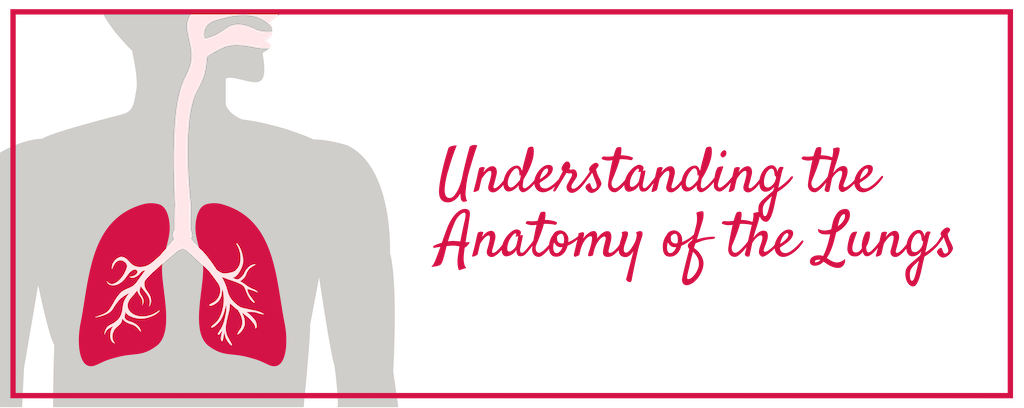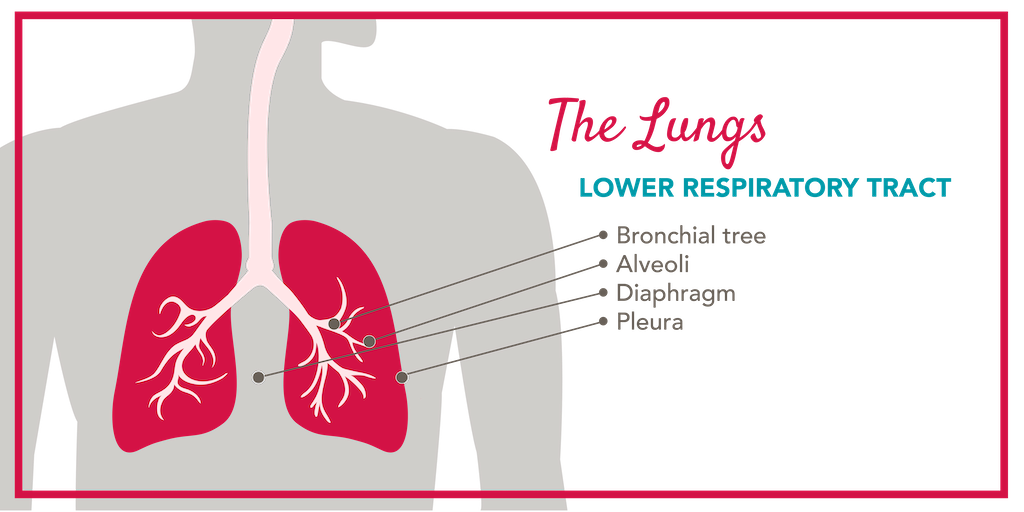
Our respiratory system is a complex network of organs and tissues responsible for the exchange of oxygen and carbon dioxide in the body. It consists of two main parts:
- The upper respiratory tract
- The lower respiratory tract

The upper respiratory tract includes the nose, nasal cavity, sinuses, pharynx, and larynx while the lower respiratory tract comprises the trachea, bronchi, and lungs.¹
Understanding the Lungs & Throat
The lungs and throat are two of the most critical components of our respiratory system.
- The lungs are responsible for absorbing oxygen and expelling carbon dioxide.
- Simultaneously, the throat (or pharynx) is a muscular tube that connects the nose and mouth to the esophagus and trachea.²
By understanding the anatomy of the lungs and throat, we can better appreciate the complexity of our respiratory system and learn how to protect it.
The Essential Role of the Respiratory System
The primary function of the respiratory system is to facilitate the exchange of oxygen and carbon dioxide. When we inhale, air enters through the nose or mouth and travels down the trachea (i.e., windpipe), which branches into two bronchi, one leading to each lung (right and left).³
The bronchi further divide into smaller tubes called bronchioles, which eventually end in tiny air sacs called alveoli. It is within these alveoli that the exchange of gasses occurs.4
The respiratory system also helps to filter, warm, and moisten the air we breathe, protecting the delicate tissues of the lungs from potential harm.
The Lungs and Their Main Components
The lungs are a pair of cone-shaped organs situated within the thoracic cavity, protected by the rib cage. They are made up of spongy, elastic tissue that allows them to expand and contract during breathing.5
The right lung is divided into three lobes, while the left lung has two lobes to accommodate the heart positioned slightly to the left.6
The major components of the lungs include:
- The bronchial tree
- Alveoli
- Diaphragm
- Pleura

Bronchial Tree
The bronchial tree is a network of tubes that branch off from the trachea, or windpipe, into the lungs. These tubes, or bronchi, divide and become smaller, forming bronchioles that eventually lead to the alveoli.7
Alveoli
The alveoli are tiny air sacs surrounded by a network of capillaries. It is within these alveoli that the exchange of oxygen and carbon dioxide takes place.
Diaphragm
The diaphragm, a dome-shaped muscle located at the base of the lungs, plays a crucial role in the process of breathing.
- When we inhale, the diaphragm contracts and moves downward, increasing the volume of the thoracic cavity and allowing air to enter the lungs.
- When we exhale, the diaphragm relaxes and moves upward, decreasing the volume of the thoracic cavity and expelling air from the lungs.
Pleura
The pleura, a thin membrane that covers the lungs and lines the chest cavity, serves to protect and support the lungs. It produces a small amount of fluid that lubricates the surfaces of the lungs, allowing them to move smoothly during breathing.8
Function of The Lung Lobes
Our lungs are made up of five lung lobes, which are responsible for performing the vital function of breathing.
The right lung has three lobes, while the left lung has two.
When you inhale, air enters the lungs and is distributed among the lobes, where it is filtered and oxygen is extracted. The oxygen then enters the bloodstream and is carried throughout the body, while carbon dioxide is expelled through the lungs when you exhale.9
The lobes of the lungs work in harmony to ensure that this process is efficient and effective, helping you to stay healthy and active.
The Structure and Function of the Throat
In addition to the complexities of the respiratory system, it’s important to understand the structure and function of the throat. It serves as a gateway for both air and food, plus it connects the nasal and oral cavities to the windpipe, allowing air to pass through to the lungs during respiration.10
This complex structure consists of several components, including:
-
- Nasopharynx
- Oropharynx
- Laryngopharynx11
Each section of the throat serves a specific purpose in the process of breathing and swallowing.
Nasopharynx
The nasopharynx, located behind the nasal cavity, plays a crucial role in filtering and humidifying the air we breathe. It is lined with cilia, which are tiny hair-like structures that trap dust particles and other impurities, preventing them from entering the lungs.12
Oropharynx
The oropharynx, also situated behind the oral cavity, serves as a passageway for both air and food.13 It is responsible for facilitating the process of swallowing, ensuring that food reaches the esophagus and not the windpipe.
Laryngopharynx
The laryngopharynx, located at the base of the throat, connects to the larynx and marks the division between the respiratory and digestive systems.14
The throat not only allows us to breathe but also enables us to communicate through speech, making it a remarkable organ!
The Role of the Larynx in the Respiratory System
The larynx, commonly known as the voice box, is a vital component of the respiratory system. Located in the upper part of the throat, it houses the vocal cords and plays a crucial role in speech production.15
The larynx consists of cartilage and muscles, which allows it to produce a wide range of sounds.
During respiration, the larynx acts as a valve, opening and closing to regulate the flow of air in and out of the lungs. When we breathe in, the vocal cords relax, allowing air to pass through freely. However, when we speak or produce sound, the vocal cords tighten, causing them to vibrate and produce different pitches.
The larynx also acts as a protective mechanism, preventing foreign objects from entering the lower respiratory system.
When we swallow, the epiglottis, a flap of tissue located above the larynx, closes off the entrance to the windpipe, ensuring that food and liquids go down the esophagus and not the trachea.16
Protecting Our Lung Health
Exposure to pollutants, smoke, and other harmful substances can damage these vital organs and lead to serious health problems, including respiratory infections or a worsening of symptoms if you have a preexisting lung condition.
Below are a few tips to protect your lungs.
- Quit smoking: Smoking is the leading cause of lung cancer and other respiratory diseases. Quitting smoking is the best thing you can do for your lung and throat health.
- Keep your home clean: Dust, mold, and other allergens can irritate your lungs and throat. Keep your home clean and dust-free to reduce your risk of respiratory problems.
- Stay hydrated: Drinking plenty of water can help keep your throat moist and healthy. It can also help flush out toxins and other harmful substances from your body.
- Exercise regularly: Regular exercise can improve your lung capacity and help keep your respiratory system healthy. Consult your clinician to plan the best exercise schedule for your lung health.
- Eat a healthy diet: A balanced diet rich in fruits, vegetables, and whole grains can help support your lung and throat health. Again, work with your clinician to plan your diet around your lungs’ needs.
- Manage stress: Stress can weaken your immune system and make you more susceptible to respiratory infections. Find healthy ways to manage stress, such as meditation or yoga.
- Perform prescribed therapy: If you have a preexisting lung condition like bronchiectasis, be sure to follow all prescribed treatment for managing symptoms.
- Get regular check-ups: Regular check-ups with your doctor can help detect any respiratory problems early, when they are easier to treat.
Want More Lung Resources?
Keep up with our blog for additional tips and resources on maintaining lung health! To discover more about the advantages of airway clearance therapy, don’t forget to request an information packet about The SmartVest Airway Clearance System.
The SmartVest Airway Clearance System is designed to safeguard your lungs by keeping mucus from accumulating and assisting in the management of your bronchiectasis symptoms.
Have questions? Request a Call with one of our registered Respiratory Therapists, or call directly at 1.855.528.5690, to learn more about your options for airway clearance!
Resources
[1] National Cancer Institute. “Conducting Passages.” Retrieved from https://training.seer.cancer.gov/anatomy/respiratory/passages/
[2] Cleveland Clinic. “Pharynx.” Retrieved from https://my.clevelandclinic.org/health/body/21869-pharynx
[3] American Lung Association. “How Lungs Work.” Retrieved from https://www.lung.org/lung-health-diseases/how-lungs-work
[4] American Lung Association. “How Lungs Work.” Retrieved from https://www.lung.org/lung-health-diseases/how-lungs-work
[5] National Heart, Lung, and Blood Institute. “How the Lungs Work.” Retrieved from https://www.nhlbi.nih.gov/health/lungs/respiratory-system
[6] Cleveland Clinic. “Lungs.” Retrieved from https://my.clevelandclinic.org/health/body/8960-lungs
[7] National Cancer Institute. ” Bronchi, Bronchial Tree, & Lungs.” Retrieved from https://training.seer.cancer.gov/anatomy/respiratory/passages/bronchi.html
[8] National Library of Medicine. “Anatomy, Thorax, Lung Pleura And Mediastinum.” Retrieved from https://www.ncbi.nlm.nih.gov/books/NBK519048/
[9] American Lung Association. “How Your Lungs Get the Job Done.” Retrieved from https://www.lung.org/blog/how-your-lungs-work
[10] Cleveland Clinic. “Pharynx.” Retrieved from https://my.clevelandclinic.org/health/body/21869-pharynx
[11] Cleveland Clinic. “Pharynx.” Retrieved from https://my.clevelandclinic.org/health/body/21869-pharynx
[12] Cleveland Clinic. “Nasopharynx.” Retrieved from https://my.clevelandclinic.org/health/body/22376-nasopharynx
[13] Cleveland Clinic. “Pharynx.” Retrieved from https://my.clevelandclinic.org/health/body/21869-pharynx
[14] Cleveland Clinic. “Pharynx.” Retrieved from https://my.clevelandclinic.org/health/body/21869-pharynx
[15] Cleveland Clinic. “Larynx (Voice Box).” Retrieved from https://my.clevelandclinic.org/health/body/21872-larynx
[16] Cleveland Clinic. “Larynx (Voice Box).” Retrieved from https://my.clevelandclinic.org/health/body/21872-larynx

